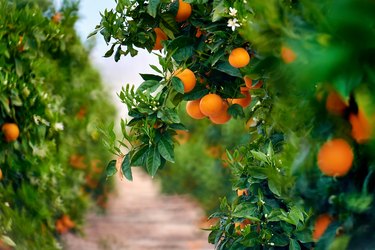
The lush evergreen leaves of your citrus tree (Citrus spp., U.S. Department of Agriculture plant hardiness zones 9 through 11) and its sweetly scented blossoms and fruits are an attractive element in your landscape or your indoor container garden. When growing citrus, the lemon, lime or orange tree leaves drooping generally indicates that your tree needs water. Before drenching the soil, look for other factors to ensure that the tree isn't sending you a different message about its health.
About Citrus Trees
Video of the Day
Citrus trees are native to Asia and have been spread through the subtropical and tropical areas of nearly every continent by traders and colonists. There are a multitude of citrus species, including green limes (Citrus aurantiifolia), yellow lemons (Citrus limon), sweet oranges (Citrus sinensis) and yellow or pink grapefruit (Citrus paradisi) plus their hybrids.
Video of the Day
These relatively small trees range from 8 to 30 feet tall and equally wide. They require full sun in a well-drained location. While mature trees can tolerate short periods in 28- to 32-degree Fahrenheit temperatures depending on the species, young trees need protection from freezing temperatures. If your hardiness zone is 8 or below, plant dwarf citrus trees in containers and take them indoors when temperatures drop below 50 degrees.
Citrus Tree Leaves Drooping
While orange, lemon and lime tree leaves drooping may well be due to water stress, citrus trees also wilt if they're overwatered. Check the soil moisture before watering the tree. If it is dry, then deep-water landscape trees or add water to container trees until it flows from the bottom of the pot. Empty the tray under the pot and water again to ensure that the soil and roots have absorbed enough moisture.
If the soil is already wet, the tree may have too much water in the soil, and the roots can't absorb nutrients and oxygen. Stop watering the tree and allow the soil to dry to a depth of 2 to 3 inches. Then, soak the soil to a depth of 2 to 3 feet. Let it dry out again before watering.
Overwatered potted citrus may need repotting to save the tree. Put on your gloves, safety goggles and long sleeves before carefully taking the tree out of the container. Remove excess potting mix around the roots and trim decaying and damaged roots with sterilized pruners. Repot in a slightly larger container with fresh, lightly moistened potting mix.
Other Factors in Wilting Citrus
Other factors that can cause wilting leaves are nutritional deficiencies, pests and diseases. Pale green, yellowed or dropping leaves may also be due to overwatering and/or nitrogen, iron or zinc deficiencies. Test the soil and add fertilizer and amendments according to the test results.
Curling, cupping or distorted leaves may indicate an aphid, scale, spider mite or other pest infestation, which may require treatment with a dishwashing liquid or insecticidal soap solution or horticultural oil. Fungal diseases of the roots and foliage can also result in damaged and wilting or drooping leaves. Avoid overwatering the tree.
Prevent fungal diseases in the foliage by avoiding wetting the foliage, especially late in the day when the water won't have time to evaporate before the sun sets. Water with a soaker hose, garden hose with a hose-end bubbler or drip watering system with several emitters. Prune lightly with sterilized pruners to remove diseased, damaged and dead branches. Thin the interior of the tree as needed to allow air circulation through its branches.
Best Indoor Citrus Tree
The best indoor citrus tree is a hybrid lemon tree. The 'Improved Meyer' lemon (Citrus meyeri) is a hybrid of a lemon and mandarin orange (Citrus reticulata). The original 'Meyer' lemon was brought to the U.S. in 1908 by Frank Meyer, but it was a host to the tristeza virus, which affected other citrus species. Only the virus-free 'Improved Meyer' is available today.
The 'Improved Meyer' is a naturally small tree, growing up to 10 feet tall and 8 feet wide outside. It can be pruned to keep it small enough for indoor container gardens. The flowers and yellow, sweet-tart fruits appear year-round when the tree is kept in a warm, sunny location and is watered and fertilized regularly. Unlike other citrus trees, this lemon-orange hybrid is thornless, and the fruits are nearly seedless.
- Missouri Botanical Garden: Citrus sinensis 'Washington'
- Harvest to Table: How to Plant, Grow, Prune, and Harvest Citrus
- UC Master Gardener Program of Alameda County: The Answers to Common Citrus Questions
- Clemson Cooperative Extension: Citrus Insects & Related Pests
- Missouri Botanical Garden: Citrus × meyeri
- Harvest to Table: Lemons for Backyard Gardens